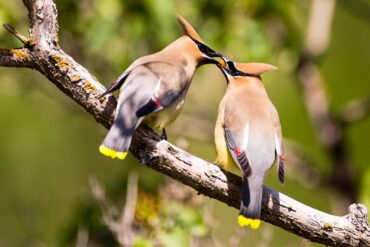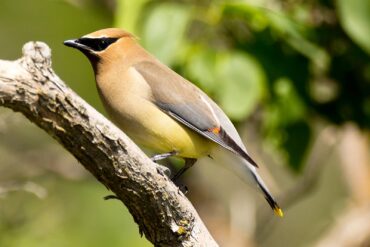
Much like people and domesticated animals, wild birds have their own personalities, unique to each species. Some are introverts, preferring a solitary life. Others appreciate their independence, but loosely associate with a few feathered friends. Then there are the extroverts that spend much of their lives in tight-knit flocks.
Whether it’s marine birds or songbirds, flocking birds are highly entertaining to watch. With little personal space to spare, tempers can flare. Disputes over the choicest foraging spots and potential mates are common.
But some birds have learned that life is easier and more enjoyable when everyone is getting along. Rather than fighting over food, they choose to share. One of the more harmonious social species is the cedar waxwing.
Of the world’s three species of waxwings, two reside in North America and can be found in Washington. The larger Bohemian waxwing sometimes winters in Eastern Washington and breeds in the Arctic.
The smaller cedar waxwing is a year-round resident of the northern United States. Breeding populations from northern Canada winter anywhere from the southern United States to Central America. In West Sound, cedar waxwings are common from May to December, with vagrants passing through in winter and early spring.
Waxwings are named for the prominent, waxy-looking red secretions (a pigment called astaxanthin) on their secondary wing feathers. Juveniles lack these red wingtips, which increase in number as the bird ages. Ornithologists believe the “waxy” wings are useful for attracting a mate.
Male and female cedar waxwings are nearly identical. They are easily distinguished from other species by their crests, black masks outlined in white, and yellow tail tips that glisten in direct sunlight. Cedar waxwings are larger than sparrows and smaller than robins. They communicate by using high-pitched calls that are sometimes inaudible to people.

Cedar waxwings vary their habitat preference, depending on the season. In spring and summer, deciduous trees, mixed forests and woodland edges, particularly those near streams, are utilized for breeding. In migration and winter, waxwings shift to brushy, open woodlands and residential areas, especially those with berries.
In spring and summer, cedar waxwings eat insects they catch by gleaning tree branches or flycatching. Later in the season, they switch to a mostly fruit diet, primarily consisting of berries. Cedar waxwings are one of the most frugivorous (fruit-eating) birds in North America, subsisting in winter almost exclusively on berries.
Cedar “berries” once dominated the winter diet of cedar waxwings, which is how they got the other half of their name. Western mountain ash, madrone, cascara, dogwood and serviceberry are native plants of Western Washington that are also known to attract cedar waxwings.
Roving flocks can number in the hundreds or thousands and sometimes mix with Bohemian waxwings, which are rare visitors to West Sound. Only staying in one place long enough to strip every last berry from a tree or shrub, waxwings have insatiable appetites.
Instead of fighting with each other for food, waxwings occasionally take a unique approach to social dining. When only one bird in a flock can reach the berries, the rest may line up on the same branch and pass multiple berries down the row.
Sometimes waxwings find an overripe batch of fruit. Upon gorging themselves, the birds may become intoxicated and unable to fly until the tipsiness wears off. Although this can be humorous to watch, it may be fatal if the bird consumes too much alcohol from the fermented fruit.
Unlike other songbirds, which regurgitate undigested fruit seeds, cedar waxwings pass intact seeds through their digestive system. This increases the dispersal of seeds that start new plants, making these birds critical members of the ecosystem.
During courtship, a male and a female cedar waxwing hop to and from one another repeatedly. The male then passes a berry or other food item back and forth with her numerous times until she finally consumes it. After that romantic encounter, they get to work selecting a nest site, likely on a sturdy horizontal branch or fork of a deciduous tree.
Cedar waxwings nest later than most birds, waiting until summer to raise a family. They do this so the young have an abundance of berries available to them in late summer and early fall.
Both parents build a nest cup of grass, twigs and moss. While the female incubates four or five eggs, the male brings her food. Both parents feed the young, which leave the nest after 15 days and are ready to join a flock of other juveniles about 10 days later.
Waxwings benefit from native plant gardens that offer insects and berries to dine on. Invasive plants and pesticide use force waxwings to search out more suitable habitat.
Anyone looking for entertainment should pay close attention to cedar waxwings. The antics of these beautiful birds can brighten your day. Don’t miss the party.

























Comments